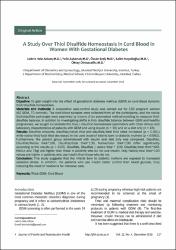| dc.contributor.author | Aktün, Lebriz Hale | |
| dc.contributor.author | Aykanat, Yeliz | |
| dc.contributor.author | Erel, Özcan | |
| dc.contributor.author | Neşelioğlu, Salim | |
| dc.contributor.author | Olmuşçelik, Oktay | |
| dc.date.accessioned | 2021-01-26T11:18:04Z | |
| dc.date.available | 2021-01-26T11:18:04Z | |
| dc.date.issued | 2018 | en_US |
| dc.identifier.citation | Aktün, L. H., Aykanat, Y., Erel, Ö., Neşelioğlu, S. ve Olmuşçelik, O. (2018). A study over thiol disulfide homeostasis in cord blood in women with gestational diabetes. Journal of Family and Reproductive Health, 12(4), 217-222. | en_US |
| dc.identifier.issn | 1735-8949 | |
| dc.identifier.issn | 1735-9392 | |
| dc.identifier.uri | https://hdl.handle.net/20.500.12511/6401 | |
| dc.description.abstract | Objective: To gain insight into the effect of gestational diabetes mellitus (GDM) on cord blood dynamic thiol/disulfide homeostasis. Materials and methods: A prospective case-control study was carried out for 132 pregnant women (62 GDM, 70 controls). The cord blood samples were collected from all the participants, and the native thiol-disulfide exchanges were examined by means of an automated method enabling to measure thiol-disulfide balance. In addition to investigating shifts in thiol disulfide balance between GDM and healthy pregnancies, we sought to correlate the thiol / disulfide homeostasis parameters with other clinical and laboratory characteristics of patients with GDM and using insulin (n = 19) and on a diet only (n = 43). Results: Disulfide amounts, disulfide/native thiol and disulfide/total thiol rates increased (p < 0.001) while native thiol/total thiol decreased in the cord blood of infants born to diabetic mothers (p < 0.001). Furthermore, the patient group administered with insulin and diet only was compared. Disulfide, Disulfide/Native thiol*100, Disulfide/total thiol*100, Native/total thiol*100 differ significantly according to the results (p < 0.05). Disulfide, Disulfide / native thiol * 100, Disulfide/total thiol*100, HbA1c and 75gr are higher than those in patients who do not use insulin. Only Native/total thiol*100 values are higher in patients who use insulin than those who do not. Conclusion: This study suggests that the infants born to diabetic mothers are exposed to increased oxidative stress. In addition, the patients who use insulin better control their blood glucose, thus reducing the need of newborns for intensive care. | en_US |
| dc.language.iso | eng | en_US |
| dc.publisher | Vali-e-Asr Reproductive Health Research Center, Tehran University of Medical Sciences | en_US |
| dc.rights | info:eu-repo/semantics/openAccess | en_US |
| dc.subject | Thiol | en_US |
| dc.subject | GDM | en_US |
| dc.subject | Cord Blood | en_US |
| dc.title | A study over thiol disulfide homeostasis in cord blood in women with gestational diabetes | en_US |
| dc.type | article | en_US |
| dc.relation.ispartof | Journal of Family and Reproductive Health | en_US |
| dc.department | İstanbul Medipol Üniversitesi, Tıp Fakültesi, Cerrahi Tıp Bilimleri Bölümü, Kadın Hastalıkları ve Doğum Ana Bilim Dalı | en_US |
| dc.authorid | 0000-0001-6141-8265 | en_US |
| dc.authorid | 0000-0001-6550-2456 | en_US |
| dc.authorid | 0000-0002-9815-1848 | en_US |
| dc.identifier.volume | 12 | en_US |
| dc.identifier.issue | 4 | en_US |
| dc.identifier.startpage | 217 | en_US |
| dc.identifier.endpage | 222 | en_US |
| dc.relation.publicationcategory | Makale - Uluslararası Hakemli Dergi - Kurum Öğretim Elemanı | en_US |


















